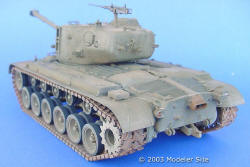|
Legal Notice
No material from Modeler Site any Web site owned, operated, licensed, or controlled by Mario Covalski & Associated may be copied, reproduced, republished, uploaded, posted, transmitted, or distributed in any way, except that you may download one copy of the materials on any single computer for your personal, non-commercial home use only, provided you keep intact all copyright and other proprietary notices. Modification of the materials or use of the materials for any other purpose is a violation of Mario Covalski & Associated's copyright and other proprietary rights.
Read More here > Legal notice
Olive Drab is a difficult colour. If it is applied too tidily, it looks monotonous and unreal and if it has too much weathering, it ends up loosing the characteristic black and yellow shades and turning into a green different from OD.
For me, the best method for weathering OD is with pigments. Pigments are a powder similar to the chalk pastels though finer and better to cover. They are found at artistic drawing suppliers. Fortunately they are cheap so it is possible to buy a good colour variety for our experiments.
For applying them it is better to dilute them with water to be added drop by drop. However, to break the liquid's surface and make the mixture run smoothly everywhere, I add a little alcohol. This way the mixture runs better than with water only.
|
Step 1
|
Once the panel highlighting and basic painting are finished and dry, we mix pigments + 50% alcohol + 50% water. The mixture should not be so coloured; just a weathering shade will be enough since pigments cover a lot. To give weathering to the OD I use grey pigments: no browns or ochres! They contrast too much with green and do not have a realistic look.
Once the grey mixture is prepared, we let it rest for some minutes so that the heavier pigment particles go to the bottom. We just use the surface liquid only and apply it on the whole model with a thick flat brush. The liquid itself will find its way everywhere and it will evaporate and leave grey marks in those places.
|
|
Step 2
|
It is important to have the model in horizontal position until the mixture evaporates. If the surface were put vertically -as the turret's walls are, the liquid would run to the lower part and it would accumulate there with almost nothing on the walls. To speed up evaporation, a hair drier may be used though moderately.
|
|
Step 3
|
To simulate vertical weathering, such as the hull and the front mudguards, we apply the mixture while keeping the part horizontally. When it is ALMOST evaporated, we drag the "mud" downwards with a brush. This operation cannot fail so it has to be done in one firm movement. These pigments are not like the chalk pastels: they cannot be washed to correct the result. We have to work patiently and little by little since the model will need to be painted once again if we exaggerate.
|
|
Step 4
|
We can add dirt to the exhaust, this time with some ochre mixed with orange. Here too we have to be careful not to overdo the weathering; it is better to have less than too much.
|
|
Step 5
|
It is possible to enhance the washed effect on the turret's walls by drawing irregular fine vertical lines very softly with smoke black pigment.
|
All the weathering processes (highlighting the panels, the irregular OD paint, pigment weathering, vertical black bands), will add a colour variety to the Olive Green without loosing personality.
The full Pershing's article > Here
Support us ordering our notes in PDF > Here
|

